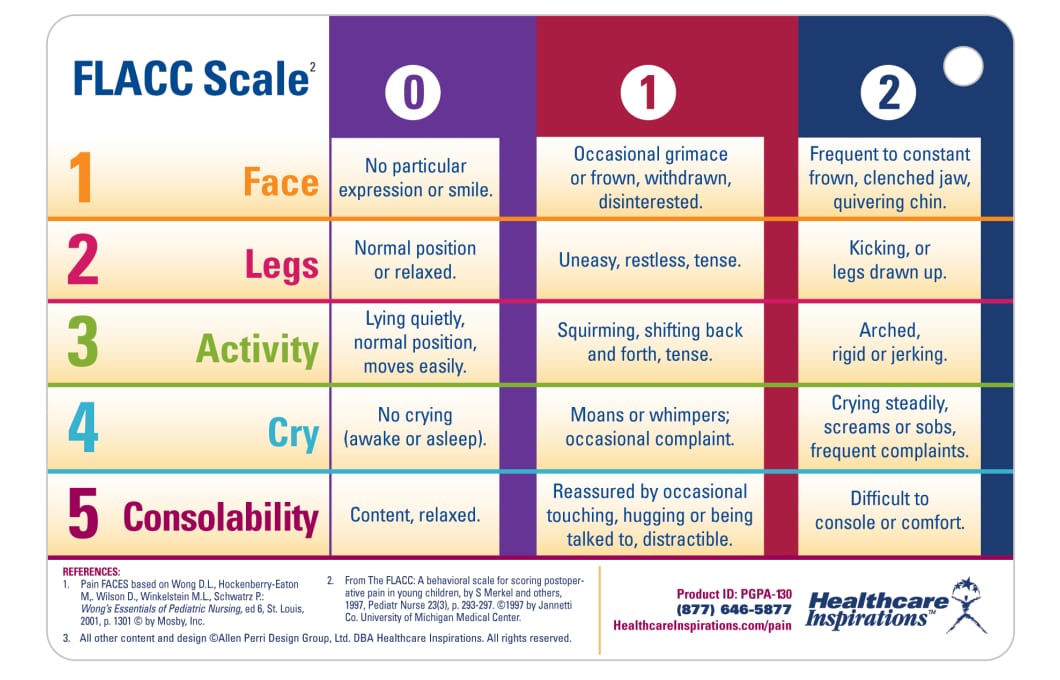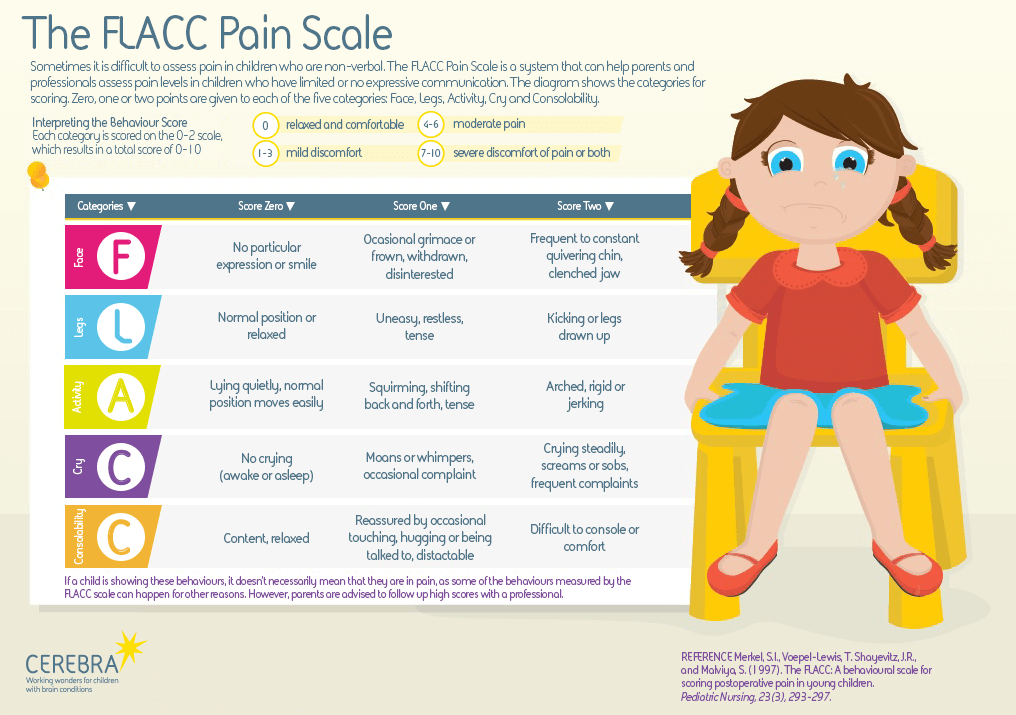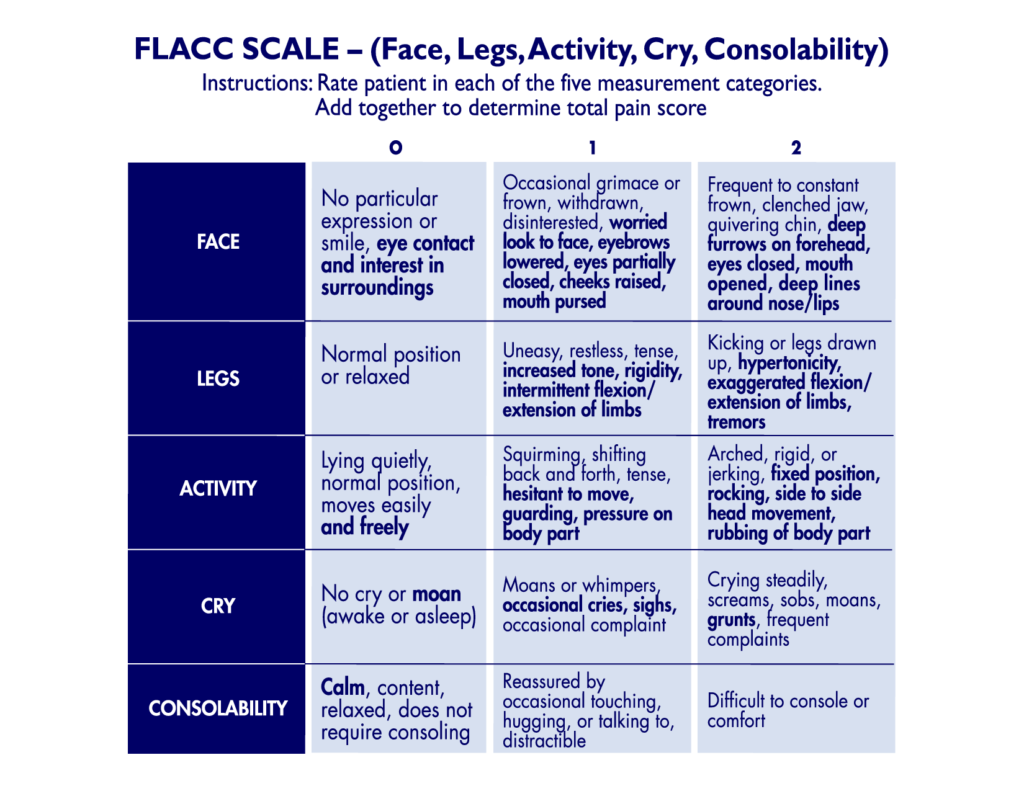Flacc Pain Scale Printable
Flacc Pain Scale Printable - Web the flacc scale is a valuable tool in pediatric care, allowing healthcare providers to objectively measure a child's pain level based on five categories: The purpose of this study was to examine the. Web flacc behavioral pain assessment scale. Observe legs and body uncovered. Face, legs, activity, cry and consolability, each with a score from 0 to 2. Web flacc is a behavioral scale for scoring postoperative pain in young children. It is widely used in the paediatric population to assess pain in infants and children. Face 0 doesn’t hurt at all. Web the following table provides the criteria for the flacc behavioural pain scale. Web score 1 if the patient responds to comfort by touching or talking in 30 seconds to 1 minute. Web the flacc scale or face, legs, activity, cry, and consolability scale is one of the most commonly and widely used behavioral observation pain scales to assess pain for. Observe legs and body uncovered. The nurse should review the descriptors within each category with the child’s parents or carers. Face 4 hurts a little. Observe for 1 to 5 minutes. Web the flacc scale or face, legs, activity, cry, and consolability scale is one of the most commonly and widely used behavioral observation pain scales to assess pain for. Add together to determine total pain score. It is widely used in the paediatric population to assess pain in infants and children. Face 2 hurts just a little bit. Web the. Web the flacc scale or face, legs, activity, cry, and consolability scale is one of the most commonly and widely used behavioral observation pain scales to assess pain for. Pain is assessed through observation of. Web score 1 if the patient responds to comfort by touching or talking in 30 seconds to 1 minute. Ask them if there are. Rate. See the different pain scales in use and how they work to qualify and quantify your pain. Web the flacc scale or face, legs, activity, cry, and consolability scale is one of the most commonly and widely used behavioral observation pain scales to assess pain for. Observe for 1 to 5 minutes or longer. Reposition patient or observe activity. Web. Web flacc is a behavioral scale for scoring postoperative pain in young children. Observe legs and body uncovered. Location, frequency, triggers of pain. Web the flacc scale is a valuable tool in pediatric care, allowing healthcare providers to objectively measure a child's pain level based on five categories: Web flacc behavioral pain assessment scale. Web the face, legs, activity, cry and consolability (flacc) scale is an observational pain scale. Add together to determine total pain score. See the different pain scales in use and how they work to qualify and quantify your pain. Degree to which pain interferes with daily activities, quality of life and sleep patterns. The nurse should review the descriptors within. Score 2 if the patient requires constant comforting or is inconsolable. Reposition patient or observe activity. Location, frequency, triggers of pain. Pain is assessed through observation of. Add together to determine total pain score. Web how to use the flacc in patients who are awake: Web score 1 if the patient responds to comfort by touching or talking in 30 seconds to 1 minute. Web flacc behavioral pain assessment scale. Web explain to the person that each face represents a person who has no pain (hurt), or some, or a lot of pain. It. Face 2 hurts just a little bit. Web flacc is a behavioral scale for scoring postoperative pain in young children. Add together to determine total pain score. Web how to use the flacc in patients who are awake: Web the flacc scale is a valuable tool in pediatric care, allowing healthcare providers to objectively measure a child's pain level based. Ask them if there are. Web flacc is a behavioral scale for scoring postoperative pain in young children. Web score 1 if the patient responds to comfort by touching or talking in 30 seconds to 1 minute. Degree to which pain interferes with daily activities, quality of life and sleep patterns. Web the following table provides the criteria for the. It is widely used in the paediatric population to assess pain in infants and children. Ask them if there are. Web flacc is a behavioral scale for scoring postoperative pain in young children. Web the flacc scale is a valuable tool in pediatric care, allowing healthcare providers to objectively measure a child's pain level based on five categories: Pain is assessed through observation of. Rate patient in each of the five measurement categories. Degree to which pain interferes with daily activities, quality of life and sleep patterns. Web the following table provides the criteria for the flacc behavioural pain scale. Location, frequency, triggers of pain. Reposition patient or observe activity. Web score 1 if the patient responds to comfort by touching or talking in 30 seconds to 1 minute. Rate patient in each of the five measurement categories. Web the flacc scale is a behavioral scale for scoring postoperative pain in children between the ages of two months and seven years or in patients unable to communicate. Observe legs and body uncovered. Web pain scales help you and your healthcare provider measure and track your pain. Web the flacc scale or face, legs, activity, cry, and consolability scale is one of the most commonly and widely used behavioral observation pain scales to assess pain for.
FLACC Pain Scale & Example Free PDF Download

Printable Flacc Pain Scale
Flacc Pain Scale Printable

FLACC Scale REBEL EM Emergency Medicine Blog

FLACC Pain Scale Infographic Cerebra

flacc pain scale Communities of Care

Flacc Pain Scale Chart Printable
FLACC Pain Scale Chart Printable

Printable Flacc Pain Scale

Printable Flacc Pain Scale
Web How To Use The Flacc In Patients Who Are Awake:
Face, Legs, Activity, Cry And Consolability, Each With A Score From 0 To 2.
Face 0 Doesn’t Hurt At All.
See The Different Pain Scales In Use And How They Work To Qualify And Quantify Your Pain.
Related Post:

